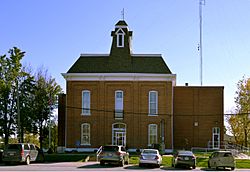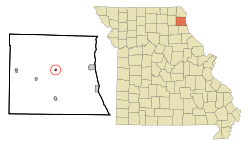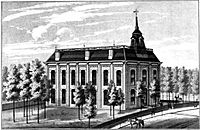Monticello, Missouri facts for kids
Quick facts for kids
Monticello, Missouri
|
|
|---|---|
|
Village
|
|

Lewis County Courthouse, October 2014
|
|

Location of Monticello, Missouri
|
|
| Country | United States |
| State | Missouri |
| County | Lewis |
| Area | |
| • Total | 0.26 sq mi (0.68 km2) |
| • Land | 0.26 sq mi (0.68 km2) |
| • Water | 0.00 sq mi (0.00 km2) |
| Elevation | 650 ft (200 m) |
| Population
(2020)
|
|
| • Total | 104 |
| • Density | 398.47/sq mi (153.88/km2) |
| Time zone | UTC-6 (Central (CST)) |
| • Summer (DST) | UTC-5 (CDT) |
| ZIP code |
63457
|
| Area code(s) | 573 |
| FIPS code | 29-49592 |
| GNIS feature ID | 2399389 |
Monticello is a small village in Lewis County, Missouri, USA. It's the main town, or county seat, for Lewis County, located by the North Fabius River. In 2020, only 104 people lived there. This makes Monticello the smallest county seat in all of Missouri!
The town got its name from Thomas Jefferson's famous home in Virginia. Monticello is also part of the larger Quincy area, which includes parts of Illinois.
Contents
A Look Back: Monticello's History
Lewis County was created on January 2, 1833. Two leaders, Stephen Cleaver and Joshua Fensel, were chosen to find the best spot for the county seat. They decided not to pick towns already built along the Mississippi River, like Tully or Canton. Instead, they chose a place closer to the center of the new county.
An early settler, Andrew P. Williams, gave 60 acres of land for the town. Monticello was planned in the fall of 1833 and officially surveyed the next year.
Building the Early Town
Judge J.A. Richardson was in charge of picking spots for important buildings. These included the courthouse, jail, a school, and a church. The streets were also named. Streets running north to south were Decatur, Jackson, Perry, Washington, and Water. East-west streets were Benton Clay, Greene, Jefferson, and Lafayette.
The first houses were built very soon after the town was planned. William Graves, James H. McBride, and William P. Richardson built these homes. A hotel, owned by William Ellis, came next.
The first Lewis County courthouse was a simple log cabin. It was finished by June 1834. This cabin was used until a bigger, two-story brick courthouse was built in 1839. Even though the North Fabius River was only good for small boats, Monticello became a busy supply center. It served central and western Lewis County, plus parts of nearby Knox and Scotland counties.
The Lewis County Courthouse was added to the National Register of Historic Places in 2005. This means it's an important historical building.
Monticello During the Civil War
During the American Civil War, many people in the Monticello area supported the Confederacy. A very important person from Monticello was Martin E. Green. He and his brother, U.S. Senator James S. Green, moved to Lewis County from Virginia in the 1830s.
While James became a lawyer and politician, Martin ran a successful sawmill. He also became a judge in Lewis County. When the Civil War started, Judge Green asked people who supported the Confederacy to gather. They met at a training camp near Monticello.
A few weeks later, Green's forces were defeated at the Battle of Athens. This battle happened in nearby Clark county. Green and his group of cavalrymen fought in many other battles. These included Lexington, Missouri, and the Battle of Pea Ridge in Arkansas. Green became a Confederate Brigadier General. He was killed during the Siege of Vicksburg in June 1863.
Other groups of fighters also clashed in the county. On July 9, 1862, a Confederate leader named Raphael Smith raided Monticello. He and his 80 men took supplies. They also made one strong Union supporter promise loyalty to the Confederacy. Smith's group tried to raid Monticello again on September 1. But they were stopped by 300 Union cavalry soldiers.
Life After the War
Times were tough for Monticello after the Civil War. Two railroads were built through the county in 1871 and 1872. But these railroads bypassed Monticello. This meant towns like Durham, Ewing, La Belle, and Lewistown grew bigger.
In 1875, a new county courthouse was needed. Rival towns saw this as a chance to become the new county seat. Towns like Canton, La Grange, and Lewistown tried to convince the county government. Lewistown offered $25,000 to build a new courthouse for free. La Grange offered to match or beat that. Canton, the county's biggest city, offered $40,000!
However, none of these towns succeeded. Monticello remained the county seat, even though its population was shrinking.
By 1878, Monticello had several businesses:
- The Lindell Hotel
- The Monticello Savings Bank
- The United States Post Office
- The Southern Hotel
- The Monticello House (a place to stay)
- A schoolhouse
- Two churches
- A weekly newspaper, the Monticello Journal
- The Monticello Seminary (a school that closed by 1887)
The population of Monticello was about 350 by the late 1890s.
Monticello's growth stayed mostly steady through the 1900s. But a farming crisis in the 1980s caused a decline. Young people also moved to bigger cities for better jobs. By the year 2000, only 126 people lived in Monticello.
Today, a few businesses still operate in Monticello because it's the county seat. These include a bank and the Missouri Department of Revenue license bureau. Children in the Monticello area now go to school at Lewis County C-1, also known as Highland school district, near Ewing.
Monticello's Location
Monticello is located at 40°7′4″N 91°42′51″W / 40.11778°N 91.71417°W. The village covers a total area of about 0.26 square miles (0.68 square kilometers). All of this area is land.
Population Facts
| Historical population | |||
|---|---|---|---|
| Census | Pop. | %± | |
| 1870 | 301 | — | |
| 1880 | 324 | 7.6% | |
| 1890 | 350 | 8.0% | |
| 1900 | 287 | −18.0% | |
| 1910 | 283 | −1.4% | |
| 1920 | 244 | −13.8% | |
| 1930 | 202 | −17.2% | |
| 1940 | 198 | −2.0% | |
| 1950 | 154 | −22.2% | |
| 1960 | 159 | 3.2% | |
| 1970 | 157 | −1.3% | |
| 1980 | 134 | −14.6% | |
| 1990 | 106 | −20.9% | |
| 2000 | 126 | 18.9% | |
| 2010 | 98 | −22.2% | |
| 2020 | 104 | 6.1% | |
| U.S. Decennial Census | |||
What the 2010 Census Showed
In 2010, there were 98 people living in Monticello. These people lived in 42 households, and 24 of these were families. The village had about 377 people per square mile. There were 49 housing units in total.
Most of the people (94.9%) were White. A small number were African American (1.0%) or Native American (3.1%). About 1.0% were from two or more races. About 3.1% of the population identified as Hispanic or Latino.
- 31.0% of households had children under 18.
- 42.9% were married couples living together.
- 9.5% had a female head of household with no husband.
- 4.8% had a male head of household with no wife.
- 42.9% were not families.
The average household had 2.14 people. The average family had 2.79 people. The average age in the village was 43 years old.
- 19.4% of residents were under 18.
- 9% were between 18 and 24.
- 28.6% were between 25 and 44.
- 29.6% were between 45 and 64.
- 13.3% were 65 or older.
The population was evenly split, with 50.0% male and 50.0% female.
Getting Around Monticello
Monticello does not have its own public transportation system. However, you can find intercity bus service in nearby Canton. This service is provided by Burlington Trailways.
Famous People from Monticello
- Edward McKendree Bounds: A writer, lawyer, and important minister.
- James S. Green: A congressman and senator from Missouri.
- Martin E. Green: A Lewis County judge who became a Confederate general during the American Civil War.
- Robert Earl Hughes: An entertainer known for being one of the heaviest people ever recorded.
See also
 In Spanish: Monticello (Misuri) para niños
In Spanish: Monticello (Misuri) para niños


